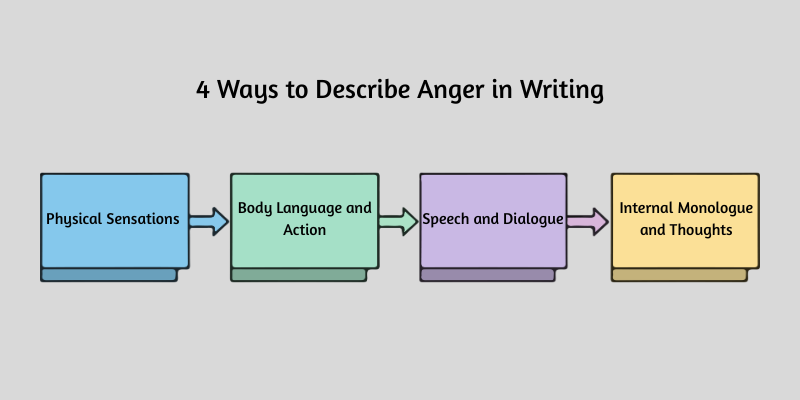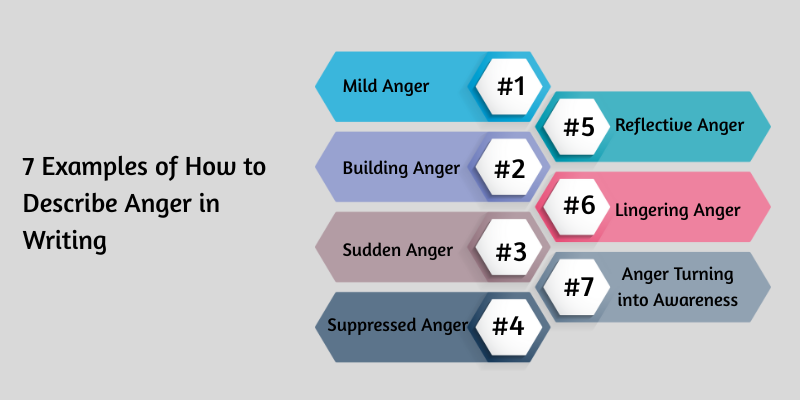
How To Describe Anger In Writing? Show, Don’t Tell
There is a fire burning in your chest, a tightness in your jaw, a storm of frustrated thoughts on a loop in your mind.
This is anger, and it demands to be felt. But holding it inside is corrosive, and lashing out often leaves a trail of damage.
There is another way to deal with this intense emotion, not through suppression or explosion, but with a simple and useful tool: a pen and a blank page.
This is not about writing for an audience or crafting a perfect story. This is a private, powerful release. It’s about taking the chaotic, painful energy of your anger and channeling it directly onto paper.
By giving your rage a concrete form through words, you begin to loosen its grip.
You transform an overwhelming emotion into something you can see, understand, and ultimately, let go. This process isn’t about politeness; it’s about liberation. Let’s begin.
4 Ways to Describe Anger in Writing

Think of describing anger like painting a picture with words. You use different colors and brushes (physical details, actions, dialogue, and thoughts) to create a complete image. Let’s look at each of these “brushes” in detail.
1. Physical Sensations: The Body’s Alarm System
Before you shout or slam a door, you feel the anger inside your body. Showing these internal cues makes the emotion feel real and immediate. It answers the question: What does anger feel like?
Internal Sensations (What the Character Feels)
- A racing heartbeat or pulse pounding in the ears. This is the body’s fight-or-flight response kicking in.
- Heat rising in the chest, neck, or face. We often talk about anger as “seeing red” or “getting hot under the collar.”
- Muscle tension: a clenched jaw so tight it aches, a tightened throat that makes it hard to speak, or shoulders hiking up toward the ears.
- Shallow, quick breaths or the feeling of not being able to catch your breath.
- A churning stomach, feeling like it’s tied in knots.
- A sense of pressure is building, like steam in a kettle about to whistle.
External, Visible Signs (What Others Might See)
- A flushed or red face, especially on the cheeks and neck.
- Veins bulging in the temples or neck.
- Sweating, particularly on the forehead or upper lip.
- Trembling in the hands or a slight shake in the voice.
- Stiff, rigid posture, as if the whole body has turned to stone.
Why it works: Starting with physical sensation grounds the emotion in the body. It’s something everyone has experienced, which makes anger relatable.
2. Body Language and Action: Anger in Motion
This is the part where you let your hand move across the page with the same tense, furious energy you feel in your body.
Don’t just write about the anger; make your writing reflect it. Let your words pace, let them slam, let them tremble.
This is how you channel the physical storm inside you into something you can see and release.
No one is reading this. So let the sentences be short and sharp. Let the lines be harsh and slanted.
Let the pages crinkle from your grip. This is your private space to act out the anger through your writing, so that you don’t have to act it out anywhere else.
Aggressive Movements
- Pacing back and forth like a caged animal.
- Storming out of a room.
- Invading personal space.
- Sudden, jerky movements like throwing up hands or turning away sharply.
Gestures
- Clenched fists at sides, white-knuckled.
- Pointing a finger or jabbing it in the air to make a point.
- Running hands through hair in frustration, making it messy.
- Crossing the arms tightly over the chest, creating a physical barrier.
- Destructive acts: slamming a door, throwing a book on a table (not necessarily at someone), or punching a wall (shows a loss of control).
Eyes and Face
- Glaring or giving a hard stare.
- Narrowing eyes to slits.
- A curled lip (a snarl) or a sneer.
- Furrowed brows, creating deep lines on the forehead.
- A refusal to make eye contact, which can show seething, quiet anger.
Use of Space
Don’t just describe the person; describe how their anger affects you or how your anger affects others.
- Do you make a room feel smaller?
- Do others step back from you?
- Does your angry energy make the air feel tense and still?
Why it works: This shift in focus is transformative. Describing how your anger landed forces you to witness your own impact from the outside. You’re not just venting; you’re conducting a raw and honest audit.
3. Speech and Dialogue: The Sound of Anger
This is your chance to get it all out. On the page, you can give voice to every sharp, ugly, unfiltered thought. Don’t hold back. Write the yell that you stifled, the cold remark you bit back, the seething silence you maintained.
Volume and Tone
- Loud: Yelling, shouting, bellowing.
- Quiet but Dangerous: A low, controlled voice, speaking through clenched teeth, a harsh whisper. This can be scarier than shouting.
- Hissing words out.
Pattern and Content
- Short, choppy sentences.
- Sarcasm and biting remarks.
- Repeating phrases or accusations.
- Insults, name-calling, or threats.
- Sudden, harsh outbursts after a period of silence.
- The cold shoulder: Complete, angry silence can be the loudest statement of all.
Let your writing embody that tone and pattern. Use ALL CAPS. Use fragments. Scratch the paper. Let your sentences become short, brutal weapons or long, rambling accusations. Repeat yourself until the point is buried in the ink and you start understanding your emotions better.
4. Internal Monologue and Thoughts: The Storm Inside
This is where you download the thoughts in your mind directly onto the page. Your private writing is the one place you can expose the frantic, obsessive, and irrational thoughts that anger creates without judgment. Let it all spill out.
Thought Patterns
- Racing, frantic thoughts that jump from one thing to another.
- Obsessive loops: replaying the insult or event over and over.
- Rhetorical questions: “How could she do this?” “Does he think I’m an idiot?”
- Extreme, black-and-white thinking: “He always does this!” “This ruins everything.”
Use Sentence Structure
Use short, sharp sentences so you can see how your mind is too angry for complex thought.
- Example: The email was there. From him. Lying. Again. My jaw clenched. My vision narrowed. How dare he.
Use Metaphor and Simile
Compare the feeling of anger to something else to make it fresh.
- Examples: “Anger boiled in my stomach like acid.” “Rage washed over me in a hot wave.”
Why it works: By giving this internal storm a concrete form, you separate yourself from the chaos. You see the thought patterns clearly, and in seeing them, you begin to calm them. This is how you drain the storm.
7 Examples of How to Describe Anger in Writing

Describing anger in writing is most powerful when it goes beyond simply stating “I was angry.” Effective emotional writing shows you how anger feels, how it behaves, and how it affects thoughts and actions.
Below are practical examples and techniques you can use to express anger clearly and authentically in your writing.
Example 1: Mild Anger
I felt irritated, like something small had been scratching at my patience all day. It wasn’t enough to explode over, but it lingered, making everything feel heavier than it should have.
Example 2: Building Anger
At first, I tried to ignore it. Then the tension grew, tightening my chest and sharpening my thoughts. Every minute I stayed silent made the anger harder to contain.
Example 3: Sudden Anger
The moment it happened, my calm vanished. My heart raced, and my thoughts snapped into focus, driven by a sharp sense of injustice I couldn’t shake.
Example 4: Suppressed Anger
I kept my voice steady, even polite, but inside I was bracing against a surge of emotion that wanted to be acknowledged. Nothing showed on the surface, yet everything felt strained.
Example 5: Reflective Anger
I wasn’t furious; I was hurt, and that hurt slowly turned into anger. The more I thought about it, the clearer it became why it mattered so much to me.
Example 6: Lingering Anger
The anger didn’t disappear after the moment passed. It followed me quietly, resurfacing when my mind went still, asking to be understood rather than ignored.
Example 7: Anger Turning into Awareness
Writing it down helped me see my anger for what it was: a response, not an identity. Once I named it, it became something I could face instead of fight.
These examples show that anger doesn’t always look the same. Sometimes it’s loud, sometimes quiet, and sometimes it reveals something deeper beneath the surface.
By seeing anger written honestly and simply, you can find specific words for emotions and begin expressing them with clarity instead of confusion.
Frequently Asked Questions (FAQs)
How to describe angry eyes in writing?
I focus on what my eyes do, not what they are. When I’m angry, my gaze hardens. My eyes narrow into cold slits or darken like a storm gathering strength. Sometimes they burn with a sharp, focused intensity; other times they glitter like chipped glass.
I describe how my stare lingers too long, how it makes people uncomfortable, how it feels like a weapon even before I speak.
How to describe an angry face in writing?
I break my face into details. My jaw locks so tightly it hurts. A muscle twitches in my cheek, betraying my control. Deep lines crease between my brows, and my nostrils flare with each measured breath.
Heat crawls up my neck, flushing my skin until I can feel it pulse. I show how anger pulls my features tight, as if my face is bracing for impact.
How to describe an angry voice in writing
When I’m angry, my voice never sounds the same. Sometimes I hiss my words through clenched teeth. Sometimes my voice drops low, rough and vibrating, more a warning than a sound.
Other times it turns sharp and brittle, cutting through the air like snapped wire. I focus on how controlled (or dangerously uncontrolled) it feels when it leaves my mouth.
How to describe an angry person in writing?
I combine everything. My posture stiffens, shoulders drawn tight. My movements become sharp, deliberate, stripped of hesitation.
Heat radiates from me, and my words come out clipped, bare of softness. I write myself as contained energy, barely held in place, something that disrupts the room just by standing in it.
How to show someone is annoyed in writing?
I let the signs be subtle. I sigh through my nose. My fingers tap against the table without rhythm. I offer a tight, polite smile that never reaches my eyes. My answers shorten, my patience thins, and I glance at the clock more often than necessary.
How to describe anger in creative writing?
This is where I let myself get vivid. I turn my anger into something physical, something alive. Sometimes it feels like a live wire buzzing beneath my skin. Other times it’s a slow-spreading stain I can’t wash out, or pressure building behind my ribs, threatening to crack me open.
I tie my anger to my environment, my history, my state of mind, so it feels specific and personal.
Conclusion
As you close this journal or put down your pen, remember this: what you’ve just done is an act of strength.
You have not ignored your anger; you have met it, faced it, and transformed its chaotic energy into clarity on the page. This is the first and most crucial step in letting go.
Carry this tool with you. Let writing be your private, immediate release valve whenever the pressure builds.
And if you find yourself wanting to build on this skill, to learn even more structured strategies for understanding and managing difficult emotions, consider joining online anger management classes. It can provide powerful tools and supportive guidance for lasting peace.
For now, we have helped you understand how to describe anger in writing, so honor the work you’ve done.





Responses